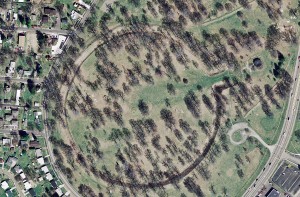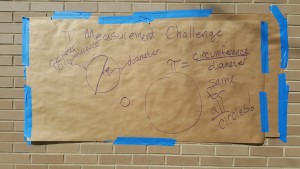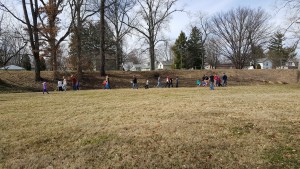The number π (pi) is the ratio of circumference to diameter in a circle. This ratio is the same for all circles, and is just a bit larger than 3. In 2015, The Aperiodical announced The π Approximation Challenge: To make a measurement of π using only basic tools and mathematical knowledge.
This year, Ohio State University at Newark has entered the challenge! We measured the circumference and diameter of the Great Circle, part of the Newark Earthworks built by native Americans 2000 years ago.
Event photos and video
The measurement was a huge success — thanks to everyone who came out to enjoy the mathematics!!!
Working in teams, we used surveyor’s wheels and string to measure the circumference and radius. Then we combined our results to make a π measurement!
Results
We had 4 teams, two for circumference and two for radius. After averaging the teams measurements, here’s what we had:
Circumference: 3372.5 ft
Diameter: 10171.5 ft
π measurement: 3.1474
Percent Error: 00.19%
Thanks
This event was a collaborative outreach event organized by mathematician Niles Johnson (OSU Newark) and historian Richard Shiels, director of the Newark Earthworks Center. Additional support has been provided by the OSU STEAM Factory. If you have further questions, please contact Niles.
Mathematics of the Newark Earthworks

The 1862 Salisbury Map of the Newark Earthworks. The Great Circle is in the lower center of the map.
The perimeter (circumference) of the Great Circle is the same as the perimeter of the Wright Earthworks Square about a mile away. And the area of the Wright Earthworks Square is the same as the area of the Observatory Circle attached to the Octagon Earthworks, even further away.
The American Indians who built these earthworks 2000 years ago must have known the relationship between circle diameter, perimeter, and area — the number that we now call π.
More information about these sites and their cultural, historical, mathematical values, take a look around the Newark Earthworks Center Blog!
The π measurement challenge
The idea for a challenge to measure π using only simple tools and mathematical knowledge started last year with The Aperiodical’s π Approximation Challenge. A number of other math enthusiasts around the world joined the challenge, and we expect 2016 to be even more fun! We’ll post other notable entries here, so check back to see other ways that people have found to measure π!
Frequently Asked Questions
Q: What age groups is this event for?
A: This is an all-ages event. Anyone who can walk can help mark lines on the circle and measure lengths. Older kids will enjoy planning their own measurements and helping combine the results. We’ll explain the mathematics at appropriate levels for any age!
Q: Can I advertise this event to my school/church/club/social group?
A: Absolutely! Like mathematics itself, this event is free and intended to be enjoyed by all. If you’d like, feel free to download our flyer and distribute widely.
Q: Will the event be postponed if the weather is bad?
A: No. In order to have our results ready for π day, we need to make the measurements rain or shine!
Q: Will there be pi(e)?!
A: The number π was certainly present! The OSU STEAM Factory generously provided additional circle-based treats (cookies).
Q: Who can I contact for more information?
A: This is a collaborative outreach event organized by mathematician Niles Johnson (OSU Newark) and historian Richard Shiels, director of the Newark Earthworks Center. If you have further questions, please contact Niles.








